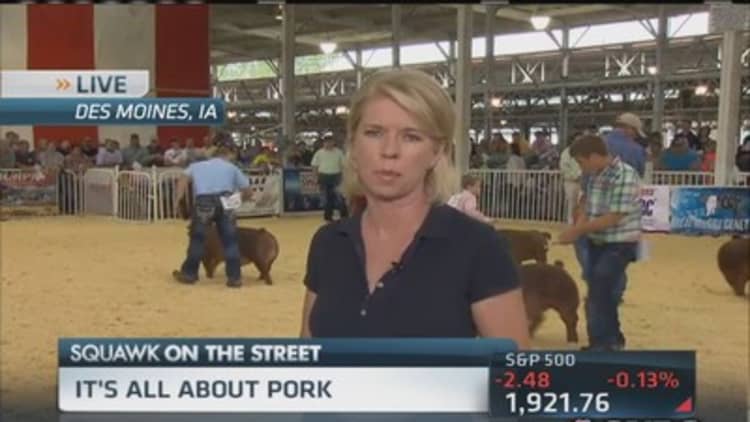
A pig virus that has killed more than 8 million American hogs is lifting pork prices. But there's more to think about than expensive ham and bacon.
The deadly Porcine Epidemic Diarrhea virus—also known as PEDv—can't be contracted by humans. The disease, however, has raised awareness about making agricultural animals, and the global nature of our food supply, more secure.
Some experts believe the virus entered the U.S. through Asia. On Friday, lawmakers focused on the safety of food and feed imports from China. And The U.S. Congressional-Executive Commission on China has scheduled a hearing for Tuesday, NBCNews.com reports.
Beyond China, biosecurity measures—which entail protecting agricultural animals from infectious diseases—was a hot topic at the recent World Pork Expo in Des Moines, Iowa. Farmers and producers swapped stories about more frequent boot and truck washes, changing clothes and cordoning off traveling pigs.
The hog industry forecasts pork supplies and prices will be impacted into later this year. But some public health advocates are thinking beyond supply and demand. They argue PEDv shows confining animals against viral outbreaks is only part of a broader solution.
And while PEDv can't be contracted by people, some public health experts can't help but recall the 2011 Hollywood thriller "Contagion." The film was a fictional account of a virus that traverses continents.
"We've already had several examples of it," said Ellen Silbergeld, a professor at Johns Hopkins Bloomberg School of Public Health. The fictional MEV-1 in "Contagion" was based on a real-life Nipah pathogen that's linked to bats and pigs.
"The point is we have a global system of humans, animals and food that moves globally and that's not going to change," Silbergeld said. "It's one giant soup of disease."
No humans affected
Last week in the Midwest, thousands of pork producers and other industry professionals converged at the Iowa State Fairgrounds for the annual pork trade show. Collectively they care for pigs and turn the animals into food, pharmaceuticals and fuel.
Biosecurity was on many people's minds.
"It's obviously a degree of concern. But for pork producers, we've long wanted to implement the best in biosecurity practices," Trent Loos, a pork producer from Litchfield, Nebraska, told CNBC last week. "We do everything we possibly can to minimize disease transmission." Loos so far hasn't been exposed to the virus in central Nebraska.
Some critics of the food and agriculture sectors want more monitoring of operations to prevent diseases. But don't expect industries to jump at more government oversight.
"We've had a lot of critics who say, 'You closed the doors and you don't let people come in and see what's going on behind those walls,' and here's why," said Loos, a sixth-generation American farmer. "We need to protect the health of the animal."
While human and animal health are part of a connected, global infrastructure, pork industry officials say it's important to keep the pig virus in perspective.
"This is not a human health issue, it's not a food safety issue," said Dave Warner, spokesman for the National Pork Producers Council. "It's only a disease of pigs."
Where did the virus come from?
The pork council is urging the U.S. Department of Agriculture to commit resources to research, testing and biosecurity measures related to PEDv.
"We need to know how this disease came into our pork herds," said Juergen Richt, veterinary medicine professor at Kansas State University in Manhattan. The virus could have entered the U.S. illegally through broken import rules. "As we know in every trade, there are people who don't follow official rules and regulations," he said.
The pathogen also could be traveling through legitimate routes, without knowledge, through feed supplements.

Richt and other experts say the viral strain likely stemmed from Asia. And it can't be ignored that China is the world's largest pork producer.
Another important unknown is how the disease is traveling among U.S. farms. "That will give us an idea of how to control it," said Warner of the pork producers council. PEDv has affected hog operations in 30 states, killing mostly pre-weaned piglets.
More protein, please
For now, part of the pig virus solution may lie in medicine. Iowa start-up Harrisvaccines has created a vaccine that reduces PEDv's harm, though can't prevent an outbreak. While the vaccine hasn't yet been approved by the USDA, rules do allow the medicine to be sold through a veterinary prescription as the company seeks the department's certification.
Read MoreIowa start-up moves to solve a deadly pig virus
So as industries track the pig virus, health experts and epidemiologists are monitoring the global health complex.
Three years ago, a National Biosurveillance Advisory Subcommittee released a report on America's ability to detect and respond to modern health threats, which include bioterrorism, radiation, infectious diseases and intoxication of pets. The report cited insufficient staffing, complexity and overlap among stakeholders, and inconsistent biosurveillance data-collecting methods and metrics.
Some public health experts say increased biosecurity is a piece of a larger puzzle. "The Porcine Epidemic Diarrhea virus is a dramatic demonstration that there really is no such thing as a confined animal operation," said Silbergeld of Johns Hopkins. Her research has spanned epidemiology and movement of pathogens across environments.
"We need a global monitoring system that is real time, and gives alerts as soon as something is detected," Silbergeld said.
The race, meanwhile, is on to pinpoint and wipe out the pig virus. Hog inventories are down, as consumers' appetite for pork and protein remains high.
"U.S. consumers have really changed their eating habits," Chris Hodges, senior vice president of business development for Smithfield Foods, told CNBC. "High-protein diets are very popular right now. And that's led to an increase in demand for protein in general, pork in particular."
—By CNBC's Heesun Wee and Brad Quick.


